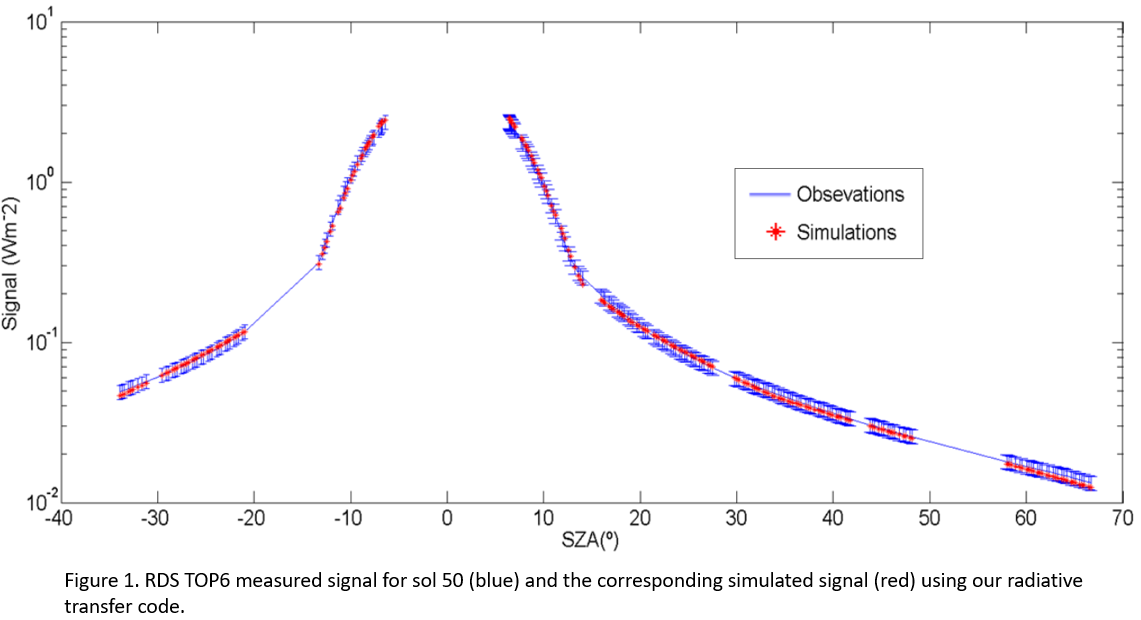- 1Instituto Nacional de Técnica Aeroespacial (INTA), Madrid, Spain (rrodvel@inta.es)
- 2Space Science Insitute, Boulder, CO, USA.
- 3NASA Godard Space Fligth Center, Greenbelt, MD, USA.
- 4Lunar and Planetary Institute, Universities Space Research Association, Houston, TX, USA.
- 5Centro de Astrobiología (INTA-CSIC), Torrejón de Ardoz, Madrid, Spain.
- 6Universidad del País Vasco UPV/EHV, Bilbao, Spain.
- 7Jet Propulsion Laboratory, California Institute of Technology, Pasadena, CA, USA.
Aerosols on Mars are a primary elements for studying the interaction between the solar radiation and the atmosphere and surface. Depending on properties such as aerosol number density, particle radius, or refractive index, the impact of the aerosols can provide positive or negative radiative feedbacks on the dynamics of the atmosphere. Previous studies have revealed large temporal and spatial variability in the aerosol optical properties, emphasizing the necessity for continuous monitoring of these properties throughout the day and at multiple locations. To address these measurements, the Radiation and Dust Sensor (RDS) [1] is part of the Mars Environmental Dynamics Analyzer (MEDA) [2] payload onboard of the Mars 2020 rover Perseverance. RDS instrument compromises two sets of 8 photodiodes (RDS-DP) and a camera (RDS-SkyCam). One set of photodiodes is pointed upward, with each one covering a different wavelength range between 190-1200 nm. The other set is pointed sideways, 20 degrees above the horizon, and they are spaced 45 degrees apart in azimuth to sample all directions at a single wavelength. The analysis of these observations with a radiative transfer model [3] (Fig. 1) allow us to fit aerosol parameters such as the aerosol opacity at different wavelengths or the aerosol particle radius. In this work we will discuss some preliminary results for the first 100 sols of Mars 2020 mission.

References:
[1] Apestigue, V., et al. “Radiation and Dust Sensor for Mars Environmental Dynamic Analyzer Onboard M2020 Rover”. Sensor 22.8 (2022): 2907.
[2] Rodriguez-Manfredi, Jose Antonio, et al. “The Mars Enviromental Dynamics Analyzer, MEDA. Asuite of enviromental sensors for the Mars 2020 mission.” Space science reviews 217.3 (2021): 1-86.
[3] Toledo, D., et al. “Measurement of aerosol optical depth and sub-visual cloud detection using the optical depth sensor (ODS)”. Atmospheric Measurement Techniques 9.2 (2016): 455-467.
How to cite: Rodriguez-Veloso, R., Toledo, D., Apéstigue, V., Arruego, I., Lemmon, M. T., Smith, M. D., Martínez, G., Vicente-Retortillo, Á., Jiménez-Martín, J. J., García-Menéndez, E., Viudez-Moreiras, D., Sánchez-Lavega, A., Pérez-Hoyos, S., Sebastian, E., de la Torre-Juárez, M., and Rodríguez-Manfredi, J. A.: Aerosol optical properties observed by MEDA Radiation an Dust Sensor (RDS) at Jezero Crater, Mars, Europlanet Science Congress 2024, Berlin, Germany, 8–13 Sep 2024, EPSC2024-508, https://doi.org/10.5194/epsc2024-508, 2024.